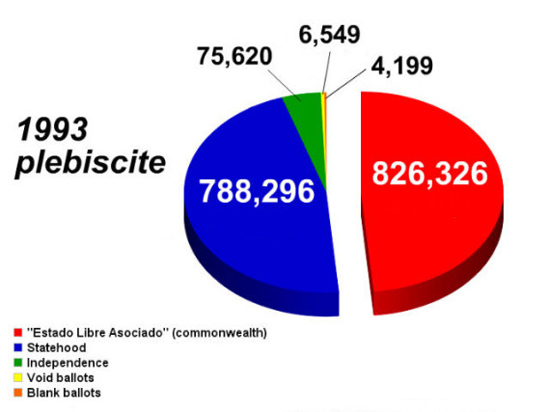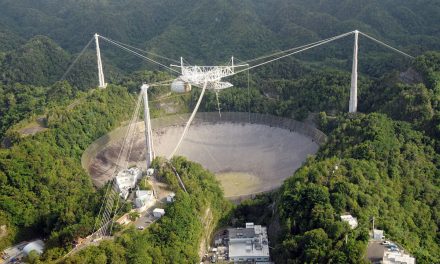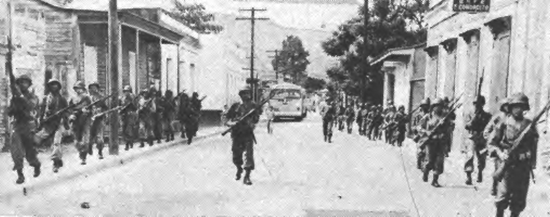
Troops_in_Jayuya. The National Guard, commanded by the Puerto Rico Adjutant General Major General Luis R. Esteves and under the orders of Gov. Luis Muñoz Marín, occupy Jayuya
The Jayuya Uprising, also known as the Jayuya Revolt or El Grito de Jayuya, refers to the revolt against the United States government which occurred on October 30, 1950 in various localities in Puerto Rico, but mostly based in the town of Jayuya, Puerto Rico.
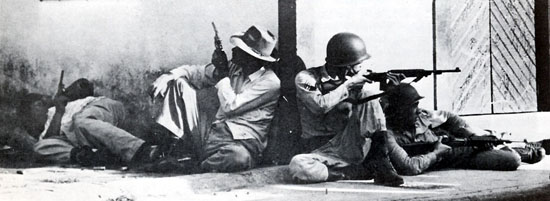
P. R. National guardsmen and undercover police fire back at Nationalists.
Events leading to the revolt
On September 17, 1922, the Puerto Rican Nationalist Party was formed. Jose Coll y Cuchi, a former member of the Union Party, was elected its first president. He wanted radical changes within the economy and social welfare programs of Puerto Rico. In 1924, Pedro Albizu Campos, a lawyer who once served in the U.S. Army during World War I as a Second Lieutenant, joined the party and was named its vice president. He believed that Puerto Rico should be an independent nation even if it meant an armed confrontation.
By 1930, Coll y Cuchi departed from the party because of his disagreements with Albizu Campos as to how the party should be run. On May 11, 1930, Albizu Campos was elected president of the Nationalist Party.
In the 1930s, the United States-appointed governor of Puerto Rico, Blanton Winship, and police colonel Riggs applied harsh repressive measures against the Nationalist Party. In 1936, Albizu Campos and the leaders of the party were arrested and jailed at the Princesa Jail in San Juan and later sent to the Federal Prison at Atlanta, Georgia. On March 21, 1937, the nationalists held a parade in Ponce and the police opened fire on the crowd in what was to become known as the Ponce Massacre. Albizu Campos returned to Puerto Rico on December 15, 1947 after spending 10 years in prison.
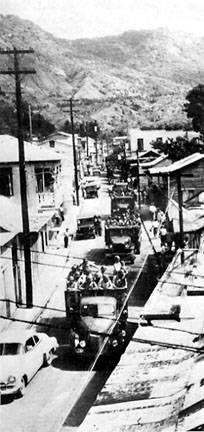 On June 11, 1948, the United States appointed Governor of Puerto Rico, Jesus T. Piñero, signed the infamous “Ley de la Mordaza” (Gag Law) or Law 53 as it was officially known, passed by the Puerto Rican legislature which made it illegal to display the Puerto Rican Flag, sing a patriotic song, talk of independence and to fight for the liberation of the island. It resembled the anti-communist passed in the United States. On June 21, 1948, Albizu Campos gave a speech in the town of Manati where nationalists from all over the island and Jayuya were gathered in case there was an attempt by the police to arrest him. Later that month Campos visited Blanca Canales and her cousins Elio and Griselio Torresola, the nationalist leaders of the town of Jayuya. Griselio soon moved to New York where he met and befriended Oscar Collazo.
On June 11, 1948, the United States appointed Governor of Puerto Rico, Jesus T. Piñero, signed the infamous “Ley de la Mordaza” (Gag Law) or Law 53 as it was officially known, passed by the Puerto Rican legislature which made it illegal to display the Puerto Rican Flag, sing a patriotic song, talk of independence and to fight for the liberation of the island. It resembled the anti-communist passed in the United States. On June 21, 1948, Albizu Campos gave a speech in the town of Manati where nationalists from all over the island and Jayuya were gathered in case there was an attempt by the police to arrest him. Later that month Campos visited Blanca Canales and her cousins Elio and Griselio Torresola, the nationalist leaders of the town of Jayuya. Griselio soon moved to New York where he met and befriended Oscar Collazo.
Uprising
From 1949 to 1950, the nationalists in the island began to plan and prepare an armed revolution. The revolution was to take place in 1952, on the date the United States Congress was to approve the creation of the political status Free Associated State (“Estado Libre Associado”) for Puerto Rico. The reason behind Albizu Campos’ call for an armed revolution was that he considered the “new” status a colonial farce. Albizu Campos picked the town of Jayuya as the headquarters of the revolution because of its location. Weapons were stored in the Canales residence.
On October 26, 1950, Albizu Campos was holding a meeting in Fajardo when he received word that his house in San Juan was surrounded by police waiting to arrest him. He was also told that the police had already arrested other nationalist leaders. He escaped from Fajardo and ordered the revolution to start. On October 27, the police in the town of Peñuelas, intercepted and fired upon a caravan of nationalists, killing four. On October 30, the nationalists staged uprisings in the towns of Ponce, Mayagüez, Naranjito, Arecibo, Utuado , San Juan Nationalist attack of San Juan, and Jayuya. The first battle of the nationalist uprisings occurred during the early hours of the day of October 29th, in the bario Macana of town of Peñuelas. The police surrounded the house of the mother of Meliton Muñiz the president of the Peñuelas Nationalist Party, under the pretext that he was storing weapons for the Nationalist Revolt. Without warning, the police fired upon the nationlists and a firefight between both factions ensued, which resulted with the death of two nationalists and six police officers wounded.
In Jayuya, Canales and the Torresolas led the armed nationalists into the town and attacked the police station. A small battle with the police occurred and one officer was killed and three others wounded before the rest dropped their weapons and surrendered. The nationalists cut the telephone lines and burned the post office. Canales led the group into the town square where the light blue version of the Puerto Rican Flag was raised (it was against the law to carry a Puerto Rican Flag from 1898 to 1952). In the town square, Canales gave a speech and declared Puerto Rico a free Republic. The United States declared martial law in Puerto Rico and sent the Puerto Rico National Guard to attack Jayuya. The town was attacked by air by U.S. bomber planes and on land by artillery. Even though part of the town was destroyed, news of this military action was prevented from spreading outside of Puerto Rico. It was called an incident between Puerto Ricans. The town was held by the nationalists for three days.
Griselio Torresola was in the United States where, together with fellow nationalist Oscar Collazo, he decided to assassinate President Harry S. Truman. On November 1, 1950, they attacked the Blair House where Torresola and White House police officer Leslie Coffelt lost their lives.
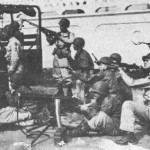
P. R. National Guard return fire at Nationalists in Jayuya.
Aftermath
The top leaders of the nationalist party were arrested, including Albizu Campos and Blanca Canales, and sent to jail to serve long prison terms. Oscar Collazo was arrested and sentenced to death. His sentence was later commuted to life imprisonment by President Truman, and he eventually received a presidential pardon. The City of Jayuya converted Blanca Canales house into a historical museum.
The last major attempt by the Puerto Rican Nationlist Party to draw world attention to Puerto Rico’s colonial situation occurred on March 1, 1954, when nationlist leader Lolita Lebron together with fellow nationalists Rafael Cancel Miranda, Irving Flores and Andres Figueroa Cordero attacked the United States House of Representatives. Lebron and her comrades were charged with attempted murder and other crimes.
Uploaded on Oct 29, 2010
October 30 is the sixtieth anniversary of the 1950 Independence Revolt in Puerto Rico by the island’s Nationalist Party. It marked the most significant attempt at armed revolution in Puerto Rico since the late nineteenth century. Democracy Now! co-host Juan Gonzalez, who’s written extensively on the uprising, discusses its significance.

